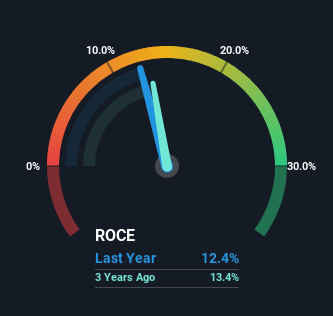- Netherlands
- /
- Commercial Services
- /
- ENXTAM:AMUND
Be Wary Of Almunda Professionals (AMS:AMUND) And Its Returns On Capital

If we want to find a stock that could multiply over the long term, what are the underlying trends we should look for? Typically, we'll want to notice a trend of growing return on capital employed (ROCE) and alongside that, an expanding base of capital employed. Basically this means that a company has profitable initiatives that it can continue to reinvest in, which is a trait of a compounding machine. However, after investigating Almunda Professionals (AMS:AMUND), we don't think it's current trends fit the mold of a multi-bagger.
Return On Capital Employed (ROCE): What Is It?
If you haven't worked with ROCE before, it measures the 'return' (pre-tax profit) a company generates from capital employed in its business. The formula for this calculation on Almunda Professionals is:
Return on Capital Employed = Earnings Before Interest and Tax (EBIT) ÷ (Total Assets - Current Liabilities)
0.12 = €3.7m ÷ (€38m - €8.5m) (Based on the trailing twelve months to December 2022).
So, Almunda Professionals has an ROCE of 12%. On its own, that's a standard return, however it's much better than the 10% generated by the Commercial Services industry.
See our latest analysis for Almunda Professionals

Historical performance is a great place to start when researching a stock so above you can see the gauge for Almunda Professionals' ROCE against it's prior returns. If you want to delve into the historical earnings, revenue and cash flow of Almunda Professionals, check out these free graphs here.
How Are Returns Trending?
In terms of Almunda Professionals' historical ROCE movements, the trend isn't fantastic. To be more specific, ROCE has fallen from 22% over the last five years. However, given capital employed and revenue have both increased it appears that the business is currently pursuing growth, at the consequence of short term returns. And if the increased capital generates additional returns, the business, and thus shareholders, will benefit in the long run.
On a related note, Almunda Professionals has decreased its current liabilities to 22% of total assets. So we could link some of this to the decrease in ROCE. Effectively this means their suppliers or short-term creditors are funding less of the business, which reduces some elements of risk. Since the business is basically funding more of its operations with it's own money, you could argue this has made the business less efficient at generating ROCE.
What We Can Learn From Almunda Professionals' ROCE
Even though returns on capital have fallen in the short term, we find it promising that revenue and capital employed have both increased for Almunda Professionals. And the stock has followed suit returning a meaningful 41% to shareholders over the last five years. So while investors seem to be recognizing these promising trends, we would look further into this stock to make sure the other metrics justify the positive view.
On a separate note, we've found 7 warning signs for Almunda Professionals you'll probably want to know about.
While Almunda Professionals may not currently earn the highest returns, we've compiled a list of companies that currently earn more than 25% return on equity. Check out this free list here.
If you're looking to trade Almunda Professionals, open an account with the lowest-cost platform trusted by professionals, Interactive Brokers.
With clients in over 200 countries and territories, and access to 160 markets, IBKR lets you trade stocks, options, futures, forex, bonds and funds from a single integrated account.
Enjoy no hidden fees, no account minimums, and FX conversion rates as low as 0.03%, far better than what most brokers offer.
Sponsored ContentNew: Manage All Your Stock Portfolios in One Place
We've created the ultimate portfolio companion for stock investors, and it's free.
• Connect an unlimited number of Portfolios and see your total in one currency
• Be alerted to new Warning Signs or Risks via email or mobile
• Track the Fair Value of your stocks
Have feedback on this article? Concerned about the content? Get in touch with us directly. Alternatively, email editorial-team (at) simplywallst.com.
This article by Simply Wall St is general in nature. We provide commentary based on historical data and analyst forecasts only using an unbiased methodology and our articles are not intended to be financial advice. It does not constitute a recommendation to buy or sell any stock, and does not take account of your objectives, or your financial situation. We aim to bring you long-term focused analysis driven by fundamental data. Note that our analysis may not factor in the latest price-sensitive company announcements or qualitative material. Simply Wall St has no position in any stocks mentioned.
About ENXTAM:AMUND
Almunda Professionals
Provides digital transformation, data management, regulatory change, and consultancy services in the Netherlands and internationally.
Moderate and fair value.
Market Insights
Community Narratives



